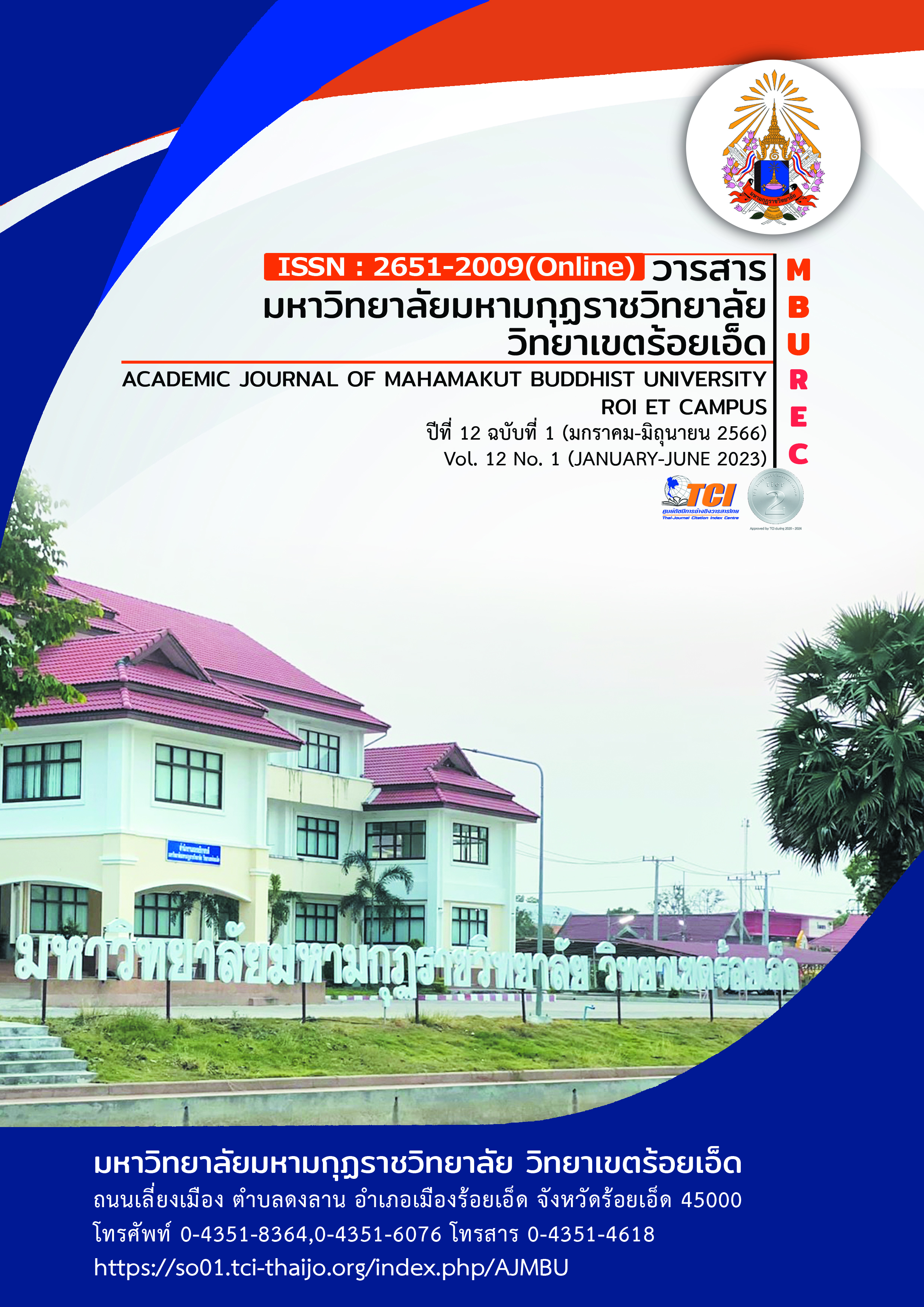AN ANALYSIS STUDY OF AESTHETIC BEAUTY OF WATSRATRAINURAK’S HOR TAI (HALL), BAN NA WIANG, NA WIANG SUB-DISTRICT, SAI MUN DISTRICT, YASOTHON PROVINCE
Main Article Content
Abstract
This research article has objectives 1) to study the aesthetic beauty of Wat Sra Trai Nurak’s Hor Trai (hall), 2) to study aesthetic concepts and theories and 3) to analyze the aesthetic beauty of Wat Sra Trai Nurak’s Hor Trai (hall), Ban Na Wiang, Na Wiang Sub-district, Sai Mun District, Yasothon Province. It was a qualitative research by to study documents and interviews with 11 qualified persons. Data were collected from documents and research, It was descriptive analysis.
The results of research found that : 1. The aesthetic beauty of Wat Sa Trai Nurak’s Hor Trai (hall) was found to be built with Burmese architecture,built by Lao craftsmen who migrated to the village. The building is made of wood facing west. The roof is made of 4 tiered cascades of wood and the door panels are carved with patterns that are unique to the architecture of Burmese and Laos. 2. Concepts and theories of aesthetic beauty found that aesthetics is a science that seeks the truth about beauty and judges beauty. There are theory of idealism, materialism, relativism, and absolutism.3. From analyzing the aesthetic beauty of Wat Sra Trai Nurak’s Hor Trai (hall), Ban Na Wiang, Na Wiang Sub-district, Yasothon Province with the theory of ideology,the materialistic theory, the theory of relativity and the theory of absolutism. The result of the analysis of the four theories. Theory is the suitable for judging the beauty of Wat Sra Trai Nurak’s Hor Trai (hall) that is the theory of relativity. for that reason, this theory uses the environment of religious, cultural and traditional beliefs of society are important elements in determining the aesthetic beauty of an art. Other theories, they are just in the judgment of beauty only.
Article Details

This work is licensed under a Creative Commons Attribution-NonCommercial-NoDerivatives 4.0 International License.
References
ดวงเดือนรุ่งฟ้า เพ็ญไพสิฐ. (2553). การศึกษาวิเคราะห์สุนทรียศาสตร์ในผลงานจิตกรรมของอาจารย์นันทวี จันทขว้าง. วิทยานิพนธ์พุทธศาสตรมหาบัณฑิต. บัณฑิตวิทยาลัย : มหาวิทยาลัยมหาจุฬาลงกรณราชวิทยาลัย.
พ่วง มีนอก. (2536). สุนทรียศาสตร์. กรุงเทพมหานคร : มหาวิทยาลัยรามคำแหง.
มูลนิธิโครงการสารานุกรมไทยสำหรับเยาวชน โดยพระราชประสงค์ในพระบาทสมเด็จพระบรมชน-กาธิเบศร มหาภูมิพลอดุลยเดชมหาราช บรมนาถบพิตร. (2564). สารานุกรมไทยสำหรับเยาวชน. สืบค้นเมื่อ 20 พฤษภาคม 2564. จาก https://www.saranukromthai.or.th/ sub/book/book.php?book=30&chap=2&page=t30-2-infodetail03.html
ลักษณวัต ปาละรัตน์. (2551). สุนทรียศาสตร์. กรุงเทพมหานคร : สำนักพิมพ์มหาวิทยาลัยรามคำแหง.
วสันต์ ชีวะสาธน์. (2552). ศาสนสถานในพุทธศาสนา : แหล่งและบทบาท. กรุงเทพมหานคร : อักษรเจริญทัศน์.
ศิริศักดิ์ อภิศักดิ์มนตรี และคณะ. (2557). หอไตรล้านนา. กรุงเทพมหานคร : กรมส่งเสริมวัฒนธรรม กระทรวงวัฒนธรรม.
สถาพร อรุณวิลาศ. (2534). การศึกษาคติความเชื่อและรูปแบบหอไตรในภาคเหนือตอนบนของประเทศไทย. วิทยานิพนธ์ปริญญาศิลปศาสตรมหาบัณฑิต สาขาวิชาโบราณคดีสมัยประวัติศาสตร์. บัณฑิตวิทยาลัย : มหาวิทยาลัยศิลปากร.
สมคิด วีระทัศนกุล. (2545). วัด : พุทธศาสนสถาปัตยกรรมไทย. พิมพ์ครั้งที่ 2. กรุงเทพมหานคร : สํานักพิมพ์มหาวิทยาลัยธรรมศาสตร์.


